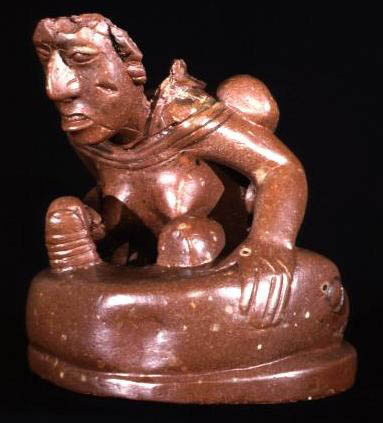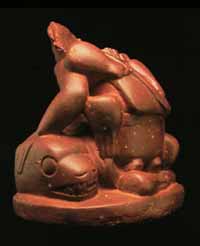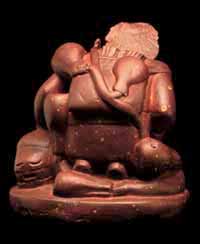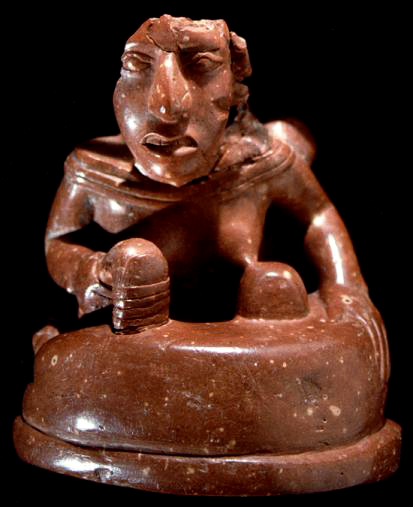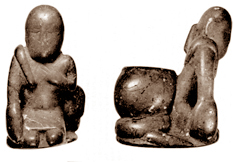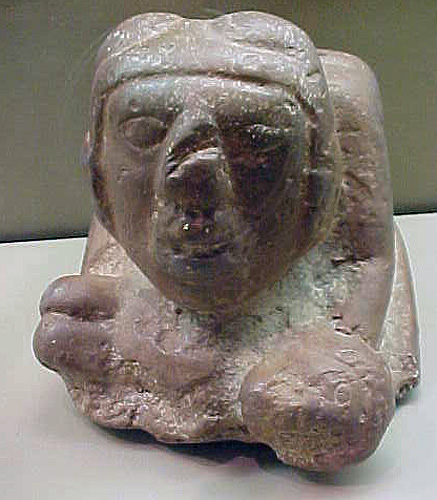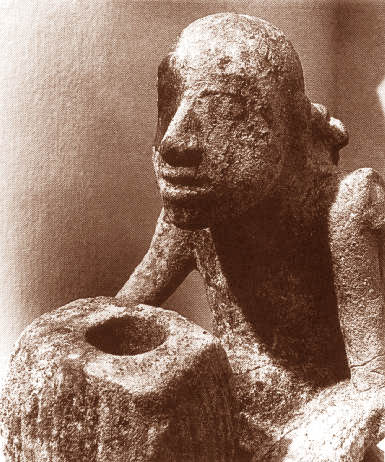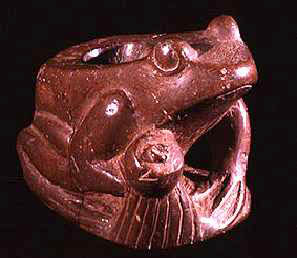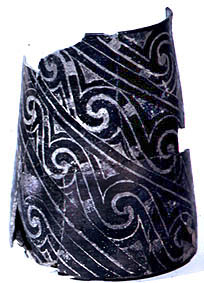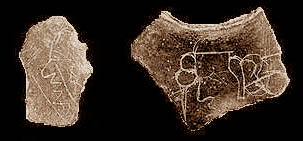The pipestone sculpture found near the Cahokia Mound, western Illinois. She is almost a thousand years old.
View from the left side, showing the woman's hand resting on the serpent's head, and gourds growing on the vine that springs out of the Earth-Snake.
Back view, showing the gourdvine ascending the woman's back, and the backpack she is wearing suspended from her shoulders by a tumpline.
The woman tills the earth which is the body of the Snake.
Some of the most stunning examples of classic North American art have been kept in obscurity, unknown to all but a few scholarly specialists. Several female "temple figures" like the ones on this page come from "small world-renewal temples near Cahokia." Some of them seem to have been ritually "killed" by a blow that broke the stone.
The one shown at left, dating to around the year 1100, is especially important. Known as the "Birger figurine," she was found in a rural temple near the boundaries of the Cahokia ceremonial complex in Madison County, Illinois. This civilization appears to have been the center of fine sculpture in pipestone (bauxite or red clay flint) which radiated artistic styles and cultural ideas over a broad swath of the lower Mississippi basin. The peoples who built mound temples from Oklahoma to Tennessee and Alabama traded with the Cahokians and were influenced by them.
This sculpture shows a woman cultivating with a hoe on ground that, on the left side, is revealed to be a serpent. The woman rests her hand on its head, and its body coils around her right side. There it splits and becomes a squash vine, part of which coils up her back, heavy with gourds. The woman wears a bundle on her back, suspended from a tumpline around her shoulders. The snake has a feline head, a theme repeated in other mound-temple art in shell, stone, and copper.
Some important comparisons have been raised by Guy Prentice between this sculpture and sacred traditions of Earth Mother, Moon, Snake Woman, and Spider Woman from various peoples of the eastern woodlands of North America. He writes, “I believe the Birger figurine to be an expression of the Earth-Mother concept—the goddess of life and death, creator of people and plants. With her help the ‘Earth-Serpent,’ symbol of death and the underworld, provides the agricultural crops that humans need.” [262]
Prentice lists several instances in which powerful female spirits wear bundles on their backs, among them Spiderwoman of the Skidi Pawnee; Snake Woman of the Caddo; Kokomthena, the Grandmother Creator of the Shawnee, and an Iroquois Old Woman tradition. (He stretches things a bit here: the last two have medicine bundles -- a very widespread concept and practice in North American tradition -- but are they described as wearing them on their backs?) The Chaui Pawnee spoke of the Old Woman Mother Moon wearing a sacred bundle on her back. They called such bundles chuhraraperu, "rains-wrapped-up."
The Pawnee said that Moon taught First Person to make a hoe, and gave seeds to the first couple, as well as teaching people how to cure. Moon has several aspects, one of which is Mother Corn. Another is Spider Woman, who is described as living with her daughter on Earth, farming corn, squash and beans. Yet another story says that the buffalo trampled Red Spider Woman into the ground where she became a squash vine. This is the origin of the squash medicine.
The Caddo said that Snake Woman learned from Great Father how to plant and prepare the seeds he gave her. She decided to give some to the people, and travelled the lands with her two sons, carrying the seeds on the backs. In other stories from the Alabama and Koasati, seeds are given to humanity in back-sacks. Often the seeds come from beneath the ground, the land of the dead, as the Micmac say of corn and tobacco. Or souls are brought up in a pack, box, reed, sack, gourd or jar. Or the living carry the bones of the dead in bundles on their backs.Prentice summarizes his impression of what the "Birger Figurine" means: "She carries the sacred bundle which may symbolize rain, lifeforce, wisdom, and divine power. “It may contain human bones or the souls of men and women in the process of being returned to the land of the living. It may also contain the first seeds of the plants given by the fertility goddess to humankind.”
“The vines may be symbols of animal and plant fertility; or they may be symbolic of the underworld origin of humans and the equation of people with plants. Two vines may symbolize the bifurcated road to the land of the dead or the twin sons of the earth goddess...The gourds may be symbols of the deity’s mythical garden.... [or] may be symbolic of female fertility as they were among the Alabama Indians where squashes were equated with female breasts; they may be symbolic of the squash medicine that cured diseases; or they may be symbolic of the return of dead souls in gourd containers, equating human life with plant life.”
SOURCES:
Prentice, Guy, An Analysis of the Symbolism Expressed by the Birger Figurine. American Antiquity, Vol 51, No. 2 (Apr 1986), pp 239-266
Thomas Emerson; Randall Hughes; Mary Hynes; Sarah Wisseman. The Sourcing and Interpretation of Cahokia-style Figurines in the Trans-Mississipppi South and Southeast, American Antiquity, Vol. 68, No. 2 (April 2003), pp 287-313, esp. p. 303
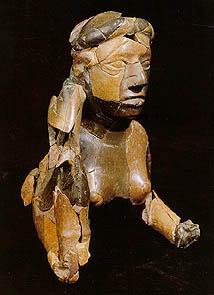 |
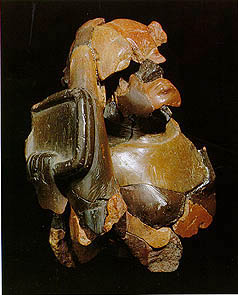 |
Here are two more female statuettes from western Illinois linked to the sacraments of corn and squash farmers. This was women's work.
Both are partially reconstructed. |
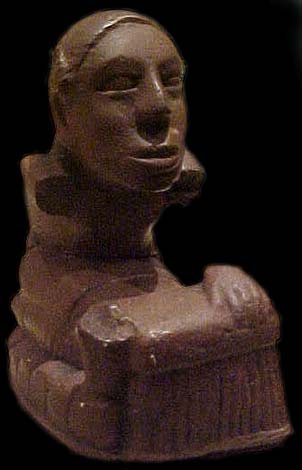 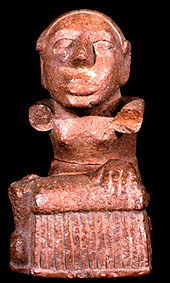 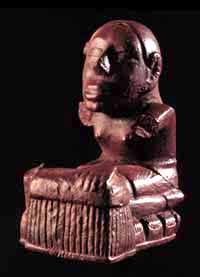 |
|
A sacred pipe in the form of a woman seated in front of a bowl or basket which rests on a snake (similar to the one at top). Its tail appears to run up the woman's back and drop over her right shoulder. She holds a hand to one breast. This is the only photograph I have been able to locate of the "Schild pipe."
Mother and baby pipe from Cahokia, Illinois
At left, a pipe from Spiro, Oklahoma in the form of a woman with a basket holding ears of corn, another visual reference to the Corn Ceremony. The pipe itself was and is a sacred object used in prayer.
Another pipe is sculpted in the form of a frog holding a shaman's rattle.
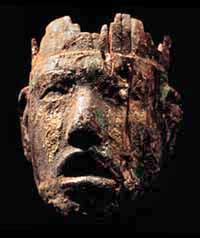
This magnificent cedar mask
comes from the Emmons site,
Fulton County, Illinois.Left, a spiral-incised vessel from
the eastern stockade at Cahokia.
Below, shards of pottery from the Cahokia temple complex are etched with human profiles: a glimpse of ceremonial regalia in the central Mississippi valley some nine centuries ago.
